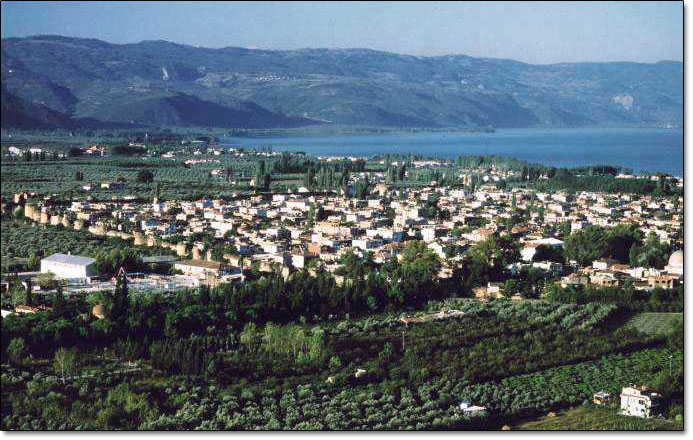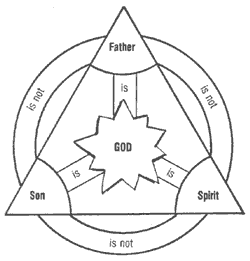The Emperor's Project
Iznik (Nicea), Turkey, today

Soon after securing himself as sole Emperor in 324, Constantine called a meeting of Christian bishops in 325 to work out a number of disputed matters in Church doctrine, worship, organization, and discipline. He invited them to a palace that he had at Nicea, in the Roman province of Bithynia. It was relatively near the capital Constantinople, but not too near, and it was a beautiful location on a lovely lake with dependably good weather. The site of the palace is reportedly now under the lake.
The bishops' agenda included the doctrine of Christ, the date of Easter, and the treatment of Christians who had renounced their faith during the persecutions.
Sources for the Council
We don't have the minutes or any other contemporary record of the Nicene Council. We know about it only from later evidence, particularly the writings of three church historians of considerable importance who wrote a century later: Socrates. Sozomen, and Theodoret. Fifty years after those three, a fourth historian, a bishop of Cyzicus known as Gelasius (although apparently that wasn't actually his true name) wrote three volumes on the Council of Nicea, and some believe that he had access to original records. This work hasn't been translated. Another source is Rufinus of Aquileia, a monk who made something of a career of translating Greek works into Latin; his Ecclesiastical History was first published in English in 1997. There are also references to the Council of Nicea in the works of Athanasius, who attended as a deacon of Alexandria.
The Arian controversy
"Arianism" refers in the first instance to the theology of Arius, a presbyter of Alexandria. But we don't have a clear sense of what his theology actually was; most of his thought is known to us only through his critics. The term "Arianism" can also be used more broadly to refer to a school of thought connected with Arius; but whether such a school of thought even existed is also disputed.
It's useful, though, to present the conventional narrative, recognizing that many historians find problems with it. In this story, Arius was influenced by the not-entirely-orthodox but hugely influential Origen (d. 253). Arius' critics accused him of denying the eternal distinctions within the Godhead, and assigning a subordinate role to Christ. The key phrase attributed to Arianism was "there was when he [the Logos, that is, Christ] was not." He apparently never said that Jesus was "merely human," but in denying the Son's coeternity with the Father, he was denying his equality in the Godhead.
The Arian controversy may have broken out in 318 when Arius' bishop, Alexander, rejected the subordination of Christ, quoting from Scripture, "I am in the Father and the Father in me." Bishop Alexander called a council of his diocese to consider Arius' teaching, which it condemned; the bishop then excommunicated him. The controversy didn't settle, however, and Constantine's theologiocal adviser, Hosius of Córdoba, cautioned the Emperor that the unity of the Church — and therefore, possibly, the security of the Empire — was at risk. That's when Constantine decided to convene the bishops at Nicea. ![]() And when they arrived, Constantine took charge, even though he wasn't a church leader and, indeed, not even a baptized member.
And when they arrived, Constantine took charge, even though he wasn't a church leader and, indeed, not even a baptized member.
(The Nicea icon here is borrowed from the website of Prof. Jaroslav Skira at Regis College, Toronto.)
For the anti-Arian party at the Council, it seemed essential to find a way to say clearly that Christ was God. That would make sense of some of Christ's statements in Scripture ("I and the Father are one"); it would establish that Christ had the authority to forgive sins, conquer death, and offers salvation; it would show that Christ was worthy of the worship that the Church was already offering him. Accordingly, the anti-Arians wanted to do more than critique Arianism; they wanted to find a positive statement of their own regarding the relation of Christ to God the Father that would affirm his deity. But finding a phraseology that definitively excluded Arianism proved remarkably tricky. The Arians could agree that Jesus, as the Son of God, was God, without agreeing that the Son was equal with the Father. It's said that the key word was suggested by Hosius: homoousios, the Son is "of the same substance" as the Father.
Assessment
The Council of Nicea has been hailed as an example of the discussion and resolution of doctrinal disagreements by the natural leaders of the Church, its bishops. It became a model for future councils of the Church.
 However, it has also been much criticized. It used language not found in Scripture to define truths which members of the Council thought that they found in Scripture. Also, by bringing the Emperor into debates about doctrine, by formally anathematizing (condemning) those Christians who disagreed with its conclusions, and by expecting the state to enforce their views, the Council politicized Christian decision-making. And, at the end of the day, the Council didn't actually settle the issue of Arianism, which remained divisive for the next fifty years.
However, it has also been much criticized. It used language not found in Scripture to define truths which members of the Council thought that they found in Scripture. Also, by bringing the Emperor into debates about doctrine, by formally anathematizing (condemning) those Christians who disagreed with its conclusions, and by expecting the state to enforce their views, the Council politicized Christian decision-making. And, at the end of the day, the Council didn't actually settle the issue of Arianism, which remained divisive for the next fifty years.
Robert Wright of General Theological Seminary summarizes three general positions that Christians have taken in relation to it:
- Reject it as post-Scriptural and non-Scriptural. Jesus taught no explicit christology. The Church does not have the authority to bind the Christian conscience with doctrines and language that go beyond Scripture.
- Accept it as is, recognizing that Christianity might well have died out if the conciliar theologians had refused to express the Christian faith in the thought-forms of the day, and affirming that the New Testament does describe Jesus as the pre-existent, only-begotten Son of God, through whom all things were created.
- Accept it as valid for its own day, but not necessarily now. Maurice Wiles, an Anglican theologian at Oxford, argued for this in The Making of Christian Doctrine, and he has many followers. The Council's terms of reference are no longer ours; we need to turn to the insights of modern thought to express the faith, just as the Nicene theologians felt free to do.
Other decisions
The bishops also sought to unify the diverse practices for determining the date of Easter. It seemed fitting that all Christians everywhere should celebrate Easter on the same day. The Council maintained the general principle of dating Easter according to the phases of the moon, just as Judaism dates Passover according to its lunar calendar. (Passover is observed on the 14th day of Nisan; Jewish months begin with the new moon, and the 14th day of the month is therefore nominally the day of the full moon.) However, although Passover can fall on any day of the week, the members of the Council wanted Easter always to fall on the Lord's Day. The result was the following declaration:
- Easter must be celebrated on a Sunday;
- this Sunday must follow the paschal moon;
- the paschal moon is the first full moon that appears following the spring ecclesiastical equinox;
- the required calculations should come under some single authority, probably the archbishop of Alexandria.
The equinox and the phases of the moon weren't determined astronomically, but according to tables.
The bishops also promulgated a number of disciplinary canons or rules, particularly to standardize some organizational and liturgical practices, and to deal with divisions and schisms in the wake of the recent persecutions.